Clematis montana



Woody
Stems and branches with a woody texture commonly associated with shrubs or perennials.
Climbing-twining
A plant that climbs using tendrils or twines around a structure.This deciduous vine has slender woody stems with tendrils and requires support to form a dense scrambling habit. It has a dark green divided leaves and the white-pink wheel-shaped fragrant flowers appear in a large cluster during late spring to summer.
Clematis montana Buch.-Ham. ex DC. is naturally found from Afghanistan to Kashmir and Myanmar in the Himalayas to Yunnan to Hubei and southern Anhui central and western China. It grows along forest margins or amongst scrubs on slopes and along streams appearing at an elevation from 1,000 m (3,280 ft) to 3,800 m (12,467 ft). It prefers a well drained fertile moist sandy to loamy or chalky soil that is acidic to alkaline with a pH range from 6.0 to 7.5. It grows in a sunny semi shaded open position with some mid day shade and is drought tender but frost tolerant with a preferred minimum temperature during the active growth period of 10ºC (50ºF).
Clematis is grown for its attractive flowers and its climbing habit. It is trained over wire fences and against walls or over arbores, archers and pergolas attracting bees and a nest for birds. It may also climb over shrubs preferring shaded roots with sun seeking foliage and is suitable for inland and mountain regions. It establishes in 1 to 2 years with an excellent show of flowers and there are many cultivars with varying flower colour. It requires a regular prune to maintain a bushy habit and has a medium water requirement once established (Scale: 2-drops from 3) preferring organic rich deep soil that is reliably moist and dislikes dry periods.
ID 32
UK hardiness zone H5
Climate zones 3B, 4, 5, 6, 8, 9, 14 - 18
USDA Zone 6-9
Clematis (klem-AH-tis) montana (mon-TAH-na)
Etymology
Genus: - Greek- Clematis – from ‘clema’ meaning (tendril) referring to the climbing habit of the plant
Species: Latin – montana – meaning (of the mountains) referring to the natural habitat of the plant
Cultivars
'Alba'
This deciduous climber produces pure white flowers from spring to early summer and grows in a semi shaded to full sun position. It prefers an organic rich moist soil and has a medium water requirement once established. (Scale: 2-drops from 3)
'H.F. Young'
This compact deciduous climber grows to 2.5 m (8 ft) tall and produces soft blue crateriform flowers up to 100 mm (4 in) wide during early summer, on the previous season's growth. It has mid-green foliage and prefers a semi shaded position, growing in USDA zones 4 - 9
'Kathleen Wheeler'
This deciduous climber produces very large plum-mauve crateriform flowers up to 230 mm (9 in) in diameter from spring to early summer, on the previous season's growth. The divided leaves have 3 broad bright green lace-shaped leaves and the new stems are reddish.
It prefers a semi shaded to full sun position and grows in organic rich moist soil that is tending acidic and has a medium water requirement once established. (Scale: 2-drops from 3) it grows in USDA zones 4 - 9
'Proteus'
This deciduous climber grows to 2.4 m (7 ft) tall with a moderate growth rate and produces soft purple-pink single or sometimes double saucer-shaped flowers up 250 mm (9 ¾ in) in diameter.
It has dark green foliage and is grown in containers or used as a spillover along retaining walls. It was raised by Charles Noble in England during 1876 and is suitable to USDA zones 5 - 6.
'Snow Flake'
This deciduous climber produces pure white scented flowers during late spring growing in a full sun to semi shaded position on well drained moist fertile soils. When selecting a position be certain that the roots are kept moist and cool.
It is drought tender but frost tolerant and has a medium water requirement once established. (Scale: 2-drops from 3) It is grown over garden trellises from the ground or in post and can be trained along fences or against a wall with support.
'Teterarose'
This deciduous climber produces larger flowers otherwise it is simular to the species.

Himalayas, central and western China
Ranunculaceae (ra-nun-kew-LAY-see-ee)
Buttercups, Monkshood, Cohosh, Columbine
This family consists of annuals, herbs, herbaceous perennial that have rhizomes or tubers and rarely shrubs or woody lianas.
Distribution
The plants are found throughout the world but mainly in the cold and temperate northern hemisphere with 75 % in East Asia and a high percentage in North America. They grow in moist to wet habitats and some are aquatic.
Diagnostic Features
The leaves are simple (palmately lobed) or compound and are arranged alternately, basal or rarely opposite, whorled or spirally and the climbers are opposite with the stipules absent and the petiole may be broadened and sheaved at the base. Some aquatic species having submerged dissected leaves.
The regular flowers are bisexual or sometimes unisexual, actinomorphic rarely zygomorphic with 3 - 5 or more free sepals that are imbricate or valvate in bud and there are 2 - 8 free petals that may be absent and are typically arranged spirally. The flowers appear solitary or in a raceme or a panicle.
The numerous stamens are hypogynous (inserted at the base of the ovary) and are spirally arranged. The ovary is superior and is 3 locular each with one or more ovule in an axil placenta. The simple style has a lobed stigma.
The fruit is an achene or a follicle, rarely a capsule or berry with many seeds with a small embryo and ample endosperm.
Note:
Plants in this family are normally associated with moist or damp soils and habitats and are found along creeks or around ponds with many species grown as ornamentals. There are 2,500 species worldwide with 50 - 60 genera and 45 species and 7 genera are found in Australia. The bulbs and sap of this genus is harmful to parrots, cockatoos and Senegal parrots if eaten
This plant tolerates between USDA zones 6a to 9a and grows to 6 m (20 ft)
Fahrenheit -10º to 25º F
These temperatures represent the lowest average.
Celsius -20.6º to -3.9º C

Attention
This plant was last revised on the 20/11/2023
All photographs and data are covered by copyright. Apart from any fair dealing for the purpose of private study, research, reference or review, as permitted under the Copyright Act, no part including images and text may be reproduced by any means without written permission. The information presented in the map is only indicative and may contain errors and omissions. All inquiries should be addressed to sales@plantfile.com attention Peter Kirkland.

Compound
The leaf that is divided into separate units (leaflets).
Trifoliolate
A compound leaf with three leaflets, with individual midribs.
Opposite
Leaves that are arranged opposite to each other.
Serrate
When the leaf margin is sharply indented (like the teeth of a saw).
Rotate
The petals form a wheel shape.
Solitary
When a flower that arises singly from within the axis of a leaf or terminally.| Jan | Feb | Mar | Apr | May | Jun |
| Jul | Aug | Sep | Oct | Nov | Dec |
The petal-less rotate flowers are to 65mm (2½in) wide and have up to 4-5 white to pink petal-like sepals and a central cluster of yellow stamens. They are arranged solitary or in a short cyme on a 50-125mm (2-5 in) long pedicels and appear from spring to summer.

Achene
It is a one-seeded indehiscent fruit with a thin pericarp and normally arranged in groups."| Jan | Feb | Mar | Apr | May | Jun |
| Jul | Aug | Sep | Oct | Nov | Dec |
The small globose achene has a white feathery style to 15mm ((2/3 in) long. The seeds are viable but the plant is commonly reproduced vegetatively to maintain true to type.
Note: Care should be taken as foliage and flowers are poisonous to humans and dogs if eaten and the sap can cause skin irritation.


Clematis is grown for its attractive flowers and its climbing habit. It is trained over wire fences and against walls or over arbores, archers and pergolas attracting bees and a nest for birds. It may also climb over shrubs preferring shaded roots with sun seeking foliage and is suitable for inland and mountain regions. It establishes in 1 to 2 years with an excellent show of flowers and there are many cultivars with varying flower colour. It requires a regular prune to maintain a bushy habit and has a medium water requirement once established preferring organic rich deep soil that is reliably moist and dislikes dry periods.
Note:
This plant is susceptible to the Rust (Puccinia rubigo-vera var. agropyri), Root Knot Nematode and the Black Blister Beetle.
These plants are naturally found on forest floors with the roots in cool moist soils that are tending alkaline and the foliage in a sunny position.
When grown in pots use stone or wood as plastic heats up quickly and is departmental to the plant which prefers cool roots.
General information
Spring flowering species require little or no pruning as the flowers appear on the previous season's growth. Autumn flowering species may be cut back hard during spring if required. When planting, position the strongest leader towards the wall and remove any weak or damaged stems. Maintain the root ball at the existing soil level and mulch with garden compost or rotted manure. Keep moist but not wet during the establishment period.
Sow fresh seed during spring, in containers. Take semi hardwood cuttings of non-flowering shoots during summer and place in a well-drained media and keep moist. Root cuttings taken during the growing period.
Propagation by Seed (General)
Germination
In order for a seed to germinate it must fulfil three conditions.
1. The embryo must be alive (a viable seed).
2. The seed must have no dormancy-inducing physiological, physical or chemical barrier to germination; also the seed must be nondormant.
3. The seed must have the appropriate environmental requirements, water, temperature and oxygen.
The interaction between these requirements and dormancy is complex and may lead to different environmental requirements that avoid the dormancy of a seed.
Sowing Seeds in Containers
There are two general methods for germinating seeds.
1. Sowing seeds in a flat or germinating bed, through which seedlings are pricked-out then, transplanted into another flat with wider spacing or directly to an individual pot.
2. Sowing seeds by placing them in to flats with the appropriate spacing or into individual pots.
This method is normally carried out with medium to large seeds such as woody plants and plants that are difficult to transplant.
Seedling production normally occurs in a greenhouse / glasshouse, cold frames and on hot beds.
Method of Seed Sowing
Fine seed is sown in pots or flats that are no deeper than 70 to 80 mm. using a sterilised well-drained media (soil). Fill the container to 20 mm from the top and sprinkle sieved peat to 3 mm depth.
Press the media down level and firm with a piece of timber and then thoroughly moisten.
Mix the fine seed with washed sand and then sow thinly on the surface. These may be lightly covered with sand.
Larger seeds may be covered with media or a hole is dibbled and the seed is placed in the media.
Watering Methods
For watering you may either mist the containers from above or place the container in tepid water and allow the water to raise through the pot to the surface of the media, then drain away and do not fill to the top of the container.
Place a piece of glass over the pot and store in a protected warm environment (glasshouse).
Seeds germinate best in darkness so shade the containers if in direct sunlight.
After the seedlings have sprouted remove the glass and ease the seedlings into direct light.
When the seedlings are large enough prick them out and transplant into larger containers and place them in a shade house to harden off.
Many seeds have different methods of seed preparation for germination such as nicking or cutting the seed coat to allow water penetration, also placing seeds in hot water and allowing it to cool off.
This is particularly important as it is softening the seed coat.
Asexual Propagation (Cuttings general)
Propagation from cuttings is possible because every cell of a plant containers the genetic information to create an entire plant.
1. Reproduction occurs through the formation of adventitious roots and shoots.
2. The uniting of vegetative parts with budding and grafting.
3. Taking stem cuttings and layering is possible due to the development of adventitious roots
4. Root cuttings can form new shoots and it is possible to join roots and shoots to form a new plant.
5. A new plant may be formed from a single cell in an aseptic culture system, (cloning).
It is important to propagate vegetatively as this form of cloning retains the unique characteristics of the cultivars or where particular aspects of a plant may be lost if propagated by seed.
Equipment Required for Taking Cuttings
1. A sharp knife that is not too large or a razor mounted in a handle.
2. Good pair of sharp secateurs that is clean.
3. A dibbler to make a hole in the media and allow the cutting to be placed in.
4. Propagation structures that are either a timber frame with glass or polyethylene cover or a glasshouse.
The object of the structure is to create an environment where the temperature and humidity can be controlled. This can be achieved with a simple cover over a pot with a wire frame and plastic.
This stops the draughts and maintains humidity.
5. A hotbed is a useful item as many plants root more quickly if the media is slightly warmer.
Bottom heat is obtained from thermostatically controlled heating cables that are running under the media.
6. Misting systems are of great benefit to cuttings as the regulated fogging with water inhibits the cuttings from drying out and as a result the cuttings may be grown in full sun.
This results in faster root development and less subject to diseases by fungi and bacteria.
7. Rooting mediums
The rooting medium must be well drained, sand may be used as long as it is thoroughly washed and leached of all salts. It is very well drained and it is excellent for cutting that root up quickly. Equal parts of sand and peat moss have good results for cuttings, which are left for a period of time to allow the roots to form.
Vermiculite and perlite are also used as a well-drained rooting media but has the same disadvantage as sand having no nutrients. The cuttings must be potted up as soon as the roots developed, or a light application of liquid fertiliser can be applied.
Types of Cuttings
Stem cuttings
These are the main types of cuttings.
1. Softwood cuttings
These cuttings are taken from young growth on side shoots and tip growth.
2. Semi hardwood cuttings
These cuttings are taken from wood that is firmer and semi ripe usually during mid summer.
3. Hardwood cuttings
These cuttings are taken from mature wood normally towards the end of the season.
4. Root cuttings
Cutting sections of roots to obtain new plants during late winter to early spring.
5. Leaf cuttings
Cutting the leaf blade in order to obtain new plants during the growing period of the plant.
Cutting preparation
Hardwood cuttings
When taking hardwood cuttings remove the leaves and in semi hardwood reduce the number of leaves by half. Cut the wood straight across just below a node or joint. Hardwood cuttings are normally between 100 to 760 mm long and may have either a heel of the older wood attached to the base, or a short section of the older wood at the base. These cuttings are prepared during the dormant season from late autumn to early spring and are made up from previous season's growth.
This type of cutting is used for woody deciduous plants such as Crepe Myrtle, Rose rootstocks and some fruit trees.
The cuttings should be healthy wood with ample supply of stored food as to nourish developing roots and shoots and placed in the rooting media with the aid of a dibbler stick.
Softwood cuttings
The cuttings for softwood should be 60 to 130 mm long and be of material with enough substance as to not deteriorate before the new roots appear. Cut below a node and retain the leaves on the upper portion. Place in a well-drained media and maintain a high humidity.
Soaking the cuttings and leaving them standing in water for long periods is undesirable.
Herbaceous cuttings
These cuttings are taken from succulent plants such as Geraniums and Coleus. The cutting should be 70 to 130 mm long with leaves retained on the upper end. As in softwood cuttings these require an environment of high humidity. Some fleshy cuttings ooze sap and may require a drying period for a few hours before being placed in the rooting media.
Leaf cutting
In these cuttings a leaf blade and petiole or part off is used to raise a new plant. The original leaf doses not become a part of the new plant as roots and shoots appear from the base of the leaf. In some cases roots appear from the severed veins.
Leaf-Bud cuttings
These cuttings incorporate a leaf, petiole and a small piece of the stem. These cuttings are an advantage where the plant uses the axillary bud at the base of the petiole for new shoot growth and maximises available propagation material, as each node will produce a new plant.
As in softwood cuttings these require an environment with high humidity and warmth.
Root cuttings
These cuttings are best taken from younger plants during late winter to early spring prior the new season's growth unless the dormant period is during summer.
Trim the roots as they are dug up and to maintain polarity cut strength at the crown end and a slanted cut at the distal end (away from the crown).
Root cuttings of small plants are placed in flats in lengths of 20 to 50 mm and laying horizontally on the surface of the soil. These may be lightly covered with sieved sand or media, watered and then placing a piece of glass or polyethylene over the container till roots / shoots appear.
Fleshy root cuttings
These cuttings should be 50 to 75 mm long and placed vertically in a well-drained sand media.
Keep the polarity correct and when the roots develop transplant the cuttings into a separate container.
Large root cuttings
These cuttings are 50 to 150 mm long and are tied up in bundles and placed in boxes of damp sand, sawdust or peat for about three weeks at a temperature of 4. 5 deg C. When taken out they should be planted in a prepared bed 50 to 80 mm apart with the tops of the cuttings level with or just below the soil level.
PEST
NAME
Whitefly, Snow flies
Various Whitefly Species
ORDER
Hemiptera
FAMILY
Aleyrodidae
Description of the Pest
This is a small sap sucking moth-like insect up to 3mm long with winged adults that have a covering of fine white powder, hence the common name. The wings are folded flat over the body and males live for one month and females live up to three months. The eggs are laid on the underside of the leaf and the wingless nymphs are immobile, flattened-round scale -like with a fringe of waxy filaments. The nymphs are translucent to greenish, congregating on young plant tissue and both adults and nymphs suck sap and producing honeydew.
There are several species such as Ash whitefly (Siphoninus phillyreae), Tobacco whitefly (Bemesia tabaci), Silverleaf whitefly and Spiralling whitefly (Aleurodicus disperses)
Greenhouse whitefly (Trialeurodes vaporariorum)
This species of whitefly normally grow to 2mm long with two pairs of wings. Their colour is due to a covering of a fine white wax and the insect has a white-moth appearance. If disturbed the insects swarm and resettle on the plant quickly. The first nymphal stage is mobile and the later stage is scale-like with fine waxy marginal hairs. These nymphal stages produce honeydew, which encourages sooty mould. It is a persistent pest commonly found in glasshouses.
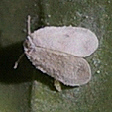 Adult
Adult 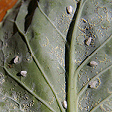 Appearance under the leaf
Appearance under the leaf
The Hakea Whitefly (Synaleurodicus hakeae) is a small, moth-like up to 0.15mm wide with wings that have a powdery coating and produce flattened scale-like nymphs. Both adult and nymph gather together in colonies and suck sap.
Appearance and Distribution of the Pest
The eggs are laid during the spring and the adults tend to stay on the underside of the leaf until disturbed, when they fly in mass and may infect other plants. Many plants are only susceptible to this insect when cultivated under glass.
Life Cycle
This insect has a Hemimetabolous life cycle, ie. When the immature nymphs resemble the adults.
White flies have a gradual metamorphosis, egg and four nymphal stages. One generation occurs from three to eight weeks and is dependant on the current weather. Hundreds of eggs are deposited on the underside of leaves in arch or circles each with a short stalk.
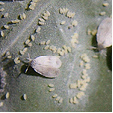 Eggs laid in a pattern
Eggs laid in a pattern 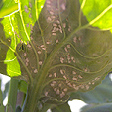 Eggs laid in a pattern
Eggs laid in a pattern
After hatching the first nymphal stage wanders around on the leaf surface for several days. Then selects a place to suck sap where it goes through all nymphal stages emerging as an adult after the fourth stage.
Period of Activity
This peat is found from tropical to temperate regions and is most active during warm weather. It is difficult to predict an infestation, as some years it is severe and other years it is absent. In glasshouse conditions it is often a problem and may extend outside the normal period of activity. They overwinter in the egg stage or find sheltered places to hide.
Damage Caused
Affected plants have leaves with yellowish to white mottling on the upper surface or with shiny secretions on new shoots or on the underside. Heavy infestations cause leaves to wilt and sooty mould to appear on the honeydew. Plant looses vigour and in some cases die.
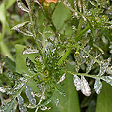
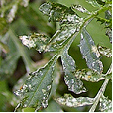 Tagetes erecta
Tagetes erecta
Susceptible Plants
Whiteflies attack a wide range of plants affected by this insect, including Abutilon, Boronia, Hibiscus and Fuchsia species. Citrus, Vegetables, Ferns and certain weed species are venerable. Australian native plants are also attacked, such as the Hakea species.
Greenhouse whitefly (Trialeurodes vaporariorum) attacks a wide range of ornamental plants, weeds and vegetables including; Phaseolus (beans), Lycopersicon (tomatoes), potatoes, Cucumis (cucurbits), Lactuca (lettuce), Dendranthema (Chrysanthemum), Dahlia and Hibiscus species.
Several ferns, including Adiantum, Asplenium, Davallia, Nephrolepis, Onychium, Platycerium and Pteris species are attacked with nymphs congregating on the underside of the fronds, normally causing little damage.
Rhododendron species are attacked by the Rhododendron White Fly (Dialeurodes chittendeni) causing yellowish mottled appearance on the upper surface of the leaf.
Cultural Control
It is difficult to control with out the application of chemicals, though strong jets of water greatly disturb the colonies. Companion plantings with basil or other aromatic plants deters white flies or spray the plants with onion-garlic spray.
In an enclosed environment sticky fly paper can reduce numbers. When the nymphal stage is found an application of white oil will reduce numbers.
Biological Control
A parasitic wasp (Encarsia Formosa) attacks nymphal stages reducing numbers. Other predators include small birds, spiders, ladybirds and there lava, hover flies, damsel flies and mantids.
Chemical Control
Plants may be sprayed with Dimethoate, permethrin, bifenthrin or pirimiphos-methyl, but some insects have immunity to chemicals. The pest may also be sprayed with a mixture of white oil and nicotine sulphate or pyrethrum.
Note
Always read the label for registration details and direction of use prior to application of any chemicals.
PEST
NAME
Capsid bugs
Lygocoris species
ORDER
Hemiptera
FAMILY
Miridae
Description of the Pest
Capsid bugs have piercing and sucking mouthparts. They have two pairs of wings, with the forewings thicker at the base and covering the hindwings at rest.
Adult bugs are up to 6 - 12 mm long the wings are coloured two thirds from the body becoming transparent at the end when flatly folded the transparent areas form an obvious diamond-shape. While feeding they secrete a toxic fluid that kills the surrounding cells. They look like large Aphids
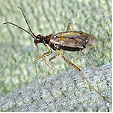 Adult
Adult 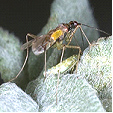 Adult with piercing and sucking mouth parts
Adult with piercing and sucking mouth parts
Life Cycle
These insects have a Hemimetabolous life cycle i.e. the nymphs resemble the adults.
Distribution of the Pest
Europe and the USA
Life Cycle
These insects have a Hemimetabolous life cycle, i.e. When the nymphs resemble the adults.
Period of Activity
The bugs are most active from late spring to late summer.
Damage Caused
After being attacked the young leaves towards the shoot tips expand and small holes with brown margins are formed. Flowers that are affected may fail to open or open unevenly with damaged petals.
The apple capsid bug (Plesiocoris rugicollis) attacks developing fruit forming blemishes on the skin but not affect the quality of the fruit.
Susceptible Plants
There are many ornamental plants that are attacked; these include Fuchsia, Chrysanthemum, Dahlia, Magnolia, Rosa, Hydrangea and Salvia species. Fruit and vegetables are also susceptible to attack.
Cultural Control
Difficult to control, infected buds may be removed during early spring.
Chemical Control
Infected buds may be sprayed in early spring
Note
It is your responsibility by law to read & follow the directions on the label of any pesticide.
Amendments by B. Sonsie Dip Hort Sc Burnley
PEST
NAME
Aphids
Various Aphid Species
ORDER
Hemiptera
FAMILY
Aphididae
Description of the Pest
The common name varies and aphids may be referred to as black fly, greenfly, ant cows or plant lice.
These small insects have soft globular body that is from 1mm to 8mm long and vary in colour from green, yellow, black and pink, with the winged forms being elongated. Both adult and nymphs, have piercing and sucking mouthparts.
Aphids are found on buds, flowers, or leaves and stems, preferring soft new growth. On older leaves the aphids are found in protected positions, such as under the leaf. Certain species of aphids form galls as they suck sap and may be found on the roots of the plant. (E.g. Woolly aphids and Black peach aphids)
Most aphids possess a pair of characteristic tubular projections, known as cornicles; these secrete a pheromone and a waxy fluid, which is thought to protect them from some of their predacious enemies.
White exoskeletons, honey dew and sooty mould indicate the presence of Aphids
Balsam Twig Aphid (Mindarus abietinus) is greenish and covered in a white wax and is normally found on the young shoots of conifers bending and killing the needles. It is found on Abies and Picea species.
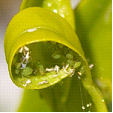 Aphid and their exoskeletons
Aphid and their exoskeletons 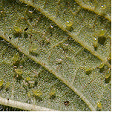 on underside of a leaf
on underside of a leaf
Black Citrus Aphid (Toxoptera aurantii) has a soft plump green body and the black coloured adults may or may not be winged. They feed in groups, curling leaves and producing honeydew attracting sooty mould.
Green Peach Aphid (Myzus persicae) is a soft plump green insect up to 0.2mm long and may be wingless. The nymphs are yellowish green and are responsible for spreading viruses in Dianthus species.
Spruce Gall Aphid (Chermes abietis) form cone shaped galls up to 12mm long resulting from the feeding. The wingless female adult lays eggs on the stems and the immature females overwinter on bud scales. Large infestation will weaken trees such as Picea abies and Pseudotsuga menziesii.
Tulip Bulb Aphid (Anuraphis tulipae) is small, waxy grey coloured and infests the underside of the bulb scales or rhizomes. They occur in the ground or on above ground parts and during storage.
Life Cycle
These insects have a Hemimetabolous life cycle, i.e. The nymphs resemble the adults.
During spring all eggs produced hatch as female nymphs. Adult Aphids are capable reproducing without fertilisation. The males are only produced in some species as the weather cools down, and the day length shortens.
Aphids are capable of giving birth to living young and large populations build up quickly during summer. Over crowding causes the aphids to become smaller, less fertile and produce more winged forms that can migrate to other host plants.
There are many different types of aphids and the life cycle varies from warm to cold climates.
Typical life cycles

Distribution of the Pest
World wide
Period of Activity
In warm climates they are seen throughout the year, but aphids dislike hot dry or cold conditions and heavy rain will decrease the population. In cold areas aphid eggs are laid around a bud base or other protected areas of the plant during autumn and emerge as nymphs during spring, feeding on the new growth.
Numbers build up quickly in the warmer months of the year. Some species feed during winter on Sow thistles.
Susceptible Plants
There is a wide range of plants attacked, from roses to vegetables, shrubs and trees. Certain aphids attack a specific genus while others have a wide range of host plants. Many are capable of transmitting plant virus diseases.
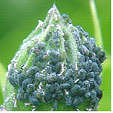 Adults and nymphs feeding
Adults and nymphs feeding 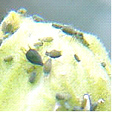 A colony of aphids
A colony of aphids
Acer species are attacked by several aphids including the Norway Maple Aphid (Periphyllus lyropictus) which is a greenish with brown markings and secret honeydew, preferring Acer platanoides. Other aphids include (Drepanaphis acerifolia) and (Periphyllus aceris) which are commonly found on the underside of leaves.
Acer species are also attacked by the Woolly Maple Aphid (Phenacoccus acericola) which covers the undersides of the leaves with a cotton-like mass
Alnus species are infested with the Alder Blight Aphid (Prociphilus tessellates) which is blue-black adult that forms woolly masses on the down-turned leaves. The nymphs overwinter in bark crevices.
Aquilegia species are attacked by several aphids including (Pergandeidia trirhoda) which is a small, flat cream coloured insect that is found on young branches and the underside of leaves.
Betula species may be attacked by the European Birch Aphid (Euceraphis betulae) which is small and yellowish or the Common Birch Aphid (Calaphis betulaecolens) which is large and green producing ample honeydew for sooty mold to grow on.
Callistephus species may be attacked by the Corn Root Aphid (Anuraphis maidi-radicis) causing the plant to become stunted, the leaves wilt and turn yellow. The aphids feed on the roots producing honeydew and are dispersed to other host by ants. It is also attacked by the Potato Aphid (Macrosiphum solanifolii).
Carya species are attacked by Gall Aphids (Phylloxera caryaecaulis) which is found on the leaves, twigs and stems forming galls and turning them black.
Chaenomeles and Gladiolus species, new growth and leaves become infested with the aphid (Aphis Gossypii)
Cupressus macrocarpa may become infested with the Cypress Aphid (Siphonartrophia cupressi).
Cyclamen species are attacked by the aphid (Myzus circumflexus) and (Aphis gossypii) which can infest healthy plants.
Dendranthema, Dianthus and Crocus species are attacked by several types of aphid including the Green Peach Aphid (Myzus persicae) and the Chrysanthemum Aphid (Macrosiphoniella sanborni).
Hibiscus species are attacked by the aphids (Aphis craccivora) and (Aphis gossypii), both congregate towards the branch tips and may cause leaf curl. Normally only seen in sub-tropical climates.
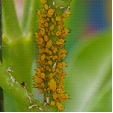 Aphids on a stem
Aphids on a stem 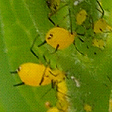 Mandevilla species
Mandevilla species
Larix species is attacked by the Woolly Larch Aphid (Adelges strobilobius). The winged adults deposit eggs at the base of the needles during spring and white woolly areas appear attached to the needles where the adult aphids feed. The young aphids overwinter in the crevices of the bark.
Mandevilla species is attacked by aphids that congregate towards the branch tips and may cause leaf curl.
Pinus species is attacked by several species of aphid including Pine Bark Aphid (Pineus strobi), Pine leaf Aphid (Pineus pinifoliae) and the White Pine Aphid (Cinara strobi).
Primula species are attacked by four species of aphid including foxglove, and green peach aphid.
Rudbeckia, Delphinium, Chrysanthemum and Helianthus species are attacked by a bright red aphid (Macrosiphum rudbeckiae).
Sorbus aucuparia is affected by the Rosy Apple and Woolly Apple aphid which attacked the foliage and young shoots.
Spiraea species are attacked by the Aphid (Aphis spiraecola) which feeds on the young shoots and flowers.
Tropaeolum species are attacked by the Black Bean Aphid (Aphis fabae), which is found in large numbers on the underside of the leaves, turning them yellow and causing them to wilt then die.
Tulipa, Iris, Freesia, Gladiolus and Zephyranthes species are infested with the Tulip Bulb Aphid.
Ulmus species are infected by two types the Woolly Apple Aphid (Eriosoma lanigerum), which curls and kills young terminal leaves and the Elm Leaf-Curl Aphid (Eriosoma ulmi) which occasionally attacks the trees.
Viburnum species are attacked by the Snowball Aphid (Anuraphis viburnicola). This aphid congregates at the end of the branches causing the leaves to curl and become deformed under which they hide.
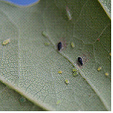 Aphids on Quercus robur
Aphids on Quercus robur
Damage Caused
Buds that have been attacked may not open, leaves and twigs become twisted or distorted and wilt. The aphids also produce honeydew, which is sticky and attracts sooty mould (fungus). This fungus forms a thick layer over the leaf, fruit or stems reducing the plants photosynthesis capability. The sooty mould spoils the plants appearance and its fruit, as does the insects white exoskeletons.
Control
Cultural Control
Aphids may be removed from a plant by hosing them off with water (limited success) or applying soapy water to aphids.. Another organic sprays can be efficient in controlling aphids. Aphids may also be removed physically by hand for small colonies on spine less plants. Species that live under ground are difficult to control but cultivation of the surrounding soil may help in controlling the infestation. (limited mainly to annual or commercial crops)
Reflective mulch around the plants also reduces numbers by repelling the insect this material is available commercially. (Reflective mulches are mainly used in market gardens for avoiding the Green peach Aphids) Resistant rootstocks are available to avoid some root feeding aphid of commercial plants, e.g. Vines and fruit trees
Biological control
Aphids are attacked by several insects includes parasitic wasps or predators such as ladybirds/ lady beetles, hover flies, lacewings, spiders.
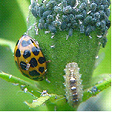
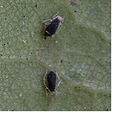 Parasitised aphids
Parasitised aphids
Chemical Control
Aphids may be controlled by spraying with a contact or systemic insecticide. The type of application used will depend on the plant is being attacked.
Aphids can be suffocated and therefore controlled with the use of e.g. White oil, Pest oil, Soapy water from soap such as Lux Flakes ®
Note
It is your responsibility by law to read & follow the directions on the label of any pesticide
Monitoring
Aphid are attracted by yellow colour and traps such as boards painted yellow and covered in glue or sticky substance will attract and trap the insects. There is also a commercially sticky yellow tape that can be attached to susceptible plants
Amendments by B. Sonsie Dip Hort Sc Burnley
PEST
NAME
Cutworms
Agrotis species
ORDER
Lepidoptera
FAMILY
Noctuidae
Description of the Pest
Cut worm larvae live in the soil, congregating in weedy areas; they chew off young seedlings at the base. They are smooth, thick fleshy grubs that vary in colour, from pinkish brown to olive green, or almost black. They grow up to 40mm long and 5mm thick. Larvae curl up when disturbed, pretending to be dead. Larvae burrow down into the soil to a depth of about 50mm to pupate. Adults are dark brown, hairy moths, with a wingspan of about 60mm.
These insects have a Holometabolous life cycle, ie. When metamorphosis is observed during the pupal stage.
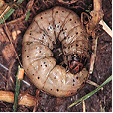
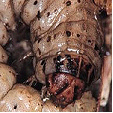
Appearance of the Pest
Adult moths are strong fliers capable of flying many kilometres laying eggs over a wide area. The eggs may remain dormant for several weeks until it rains or emerge within a few days under the right weather conditions.
Three similar species are commonly found in Australia:
· Agrotis ifusa (Bogong moth) is up to 50mm across and has three spots on its forewing.
· Agrotis munda (pink cut worm); and
· Agrotis ipsilon (black cut worm).
 Agrotis munda
Agrotis munda
Period of Activity
Different species are active throughout the year, their prevalence being determined by rainfall and temperature. They are normally most active at night. Larvae will appear in greatest numbers when favourable environmental conditions produce lush growth.
Susceptible Plants
Cutworms prefer soft, succulent seedlings or fleshy annuals, perennials and a variety for ferns or orchids. They feed at night and remain in the soil during the day. They are most commonly found in soil that is infested with weeds or soil that is poorly drained and moist. Well-drained soils harbour less lava.
Senecio and Dianthus species are attacked by the Cutworm (Peridroma margaritosa) which eats seedlings, leaves and flower buds. Under glasshouse conditions all stages of the lifecycle are present.
Turf Grasses are attacked by several Agrotis species causing damage during different seasons according to there individual life cycle. All feed at night on the leaves when young and mature larvae shear plants stems at ground level.
Damage Caused
Young larvae feed on the lower epidermis of leaves. Adults attack stems and seedlings at the base, eating the soft new growth, on one side, or completely through. The damaged plant normally topples over (hence the common name). Mature plants may wilt or the foliage becomes yellowish as a result of the damage, but normally recovers.
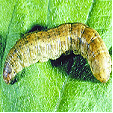
Cultural Control
Weed removal and cultivation to improve the drainage of the soil will provide some reduction in of numbers. Seedlings may be protected by a physical barrier, (eg plastic tube pushed into the soil around the seedling). Heavily infected soil can be laid fallow with for several weeks to disrupt the life cycle or the soil can be covered in black or clear plastic until weeds and lava are dead.
A molasses based bait that has hardwood sawdust and bran mixed with water creates a stick mass that the lava is attracted to but cannot escape. At sunrise they die from dehydration.
Biological Control
Natural predators such as birds, ground beetles and certain bugs help keep numbers down. Wasps and certain species of flies also attack the lava.
Encouraging earthworms by mulching and increasing the humus level is an excellent way to rid the soil of lava.
Chemical Control
Chemical treatment (Carbaryl) may be effective if sprayed in the evening, when the caterpillars emerge to feed.
Note
Always read the label for registration details and direction of use prior to application of any chemicals.
PEST
NAME
Slugs and Snails
Various Snails Species
Description of the Pest
Slugs and snails are land molluscs. Snails produce an external spiral shell; slugs do not. The common garden snail Helix asperasa, grows up to 25 mm, long. Its body is slimy, broad, elongated and greyish, with two pairs of reticulated tentacles, with eyes at the ends of the longer pair. The mouth parts of snails and slugs contain a file-like organ known as the radula, which is used to rasp away at the host plant's tissue. Movement of the animal is by a muscular sliding movement, along a slippery trail of mucous; this solidifies on exposure to the air (typically described as a "silvery trail").
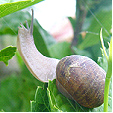
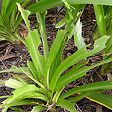
Appearance and Distribution of the Pest
Slugs and snails occur world-wide. Slugs tend to be more prevalent in heavier soil types.
Life Cycle
These insects have a Hemimetabolous life cycle, ie. When the immature nymphs resemble the adults.
Snail eggs are laid in moist soil, 20-40mm deep; eggs are white, spherical and appear in clusters of 30-100. Under favourable conditions, eggs hatch in 2-3 weeks. Newly emerged snails resemble tiny adults. When the weather is cold and dry, snails seal themselves into their shells where they survive, dormant, for 1-3 years.
Period of Activity
More active during the warmer months, although some species may remain active throughout the year.
Damage Caused
Native Australian slugs and snails are not commercial pests. Introduced species chew holes in foliage or skeletonise leaves; some plants may be completely defoliated plants; tubers and seedlings may be completely eaten. Slugs and snails feed mainly at night, especially after rain or watering; they shelter in cool, moist locations during the day. When the weather is dry, snails seal themselves into their shells with a mucous membrane, where they survive, dormant, for 1-3 years. Some species may consume up to one third of their body weight each day.
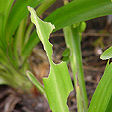
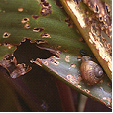
Susceptible Plants
A wide range of leafy plants, including ground crops, potatoes, tubers, leafy vegetables and seedlings.
Fern species are attacked causing serious damage. New fronds are repetitively eaten causing the plant to become stunted. Attacks are normally more severe during wet periods during which time control measures should be taken.
Morinda citrifolia is attacked by the Giant African Snail (Achatina fulica) which defoliates trees.
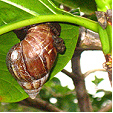

Cultural Control
Remove possible hiding places and avoid overhead watering to reduce humidity. Cultivate soil regularly; in commercial situations, allow the soil to remain fallow for one season to reduce numbers. Domestic infestations may be removed by hand. Traps may be created by inverting small pots near where snails and slugs are feeding; they will gather in these shelters during the day, and may be collected and destroyed. The popular Australian "beer trap" consists of a vertically-sided container, sunk into the ground and filled with beer, which intoxicates and drowns the snails.
Biological Control
Natural predators such as birds, frogs, and lizards reduce numbers, but do not provide effective control. Orchardists have used running ducks to control snails with some success.
Chemical Control
Commercial baits - molluscicides - made from methiocarb or metaldehyde are effective when used in combination with sanitation. Their effectiveness varies according to soil and weather conditions; it is generally recommended to avoid watering after application.
Note
Always read the label for registration details and direction of use prior to application of any chemicals.
PEST
NAME
Earwigs
Various Earwigs Species
ORDER
Dermaptera
Description of the Pest
Earwigs are slender insect with large pair of curved forceps at the rear of the abdomen and may be black to brownish. All Earwigs lay eggs in groups of 50 in the soil up to 50mm deep and tend the new borne for up to two weeks.
These insects have a Hemimetabolous life cycle, ie. When the immature nymphs resemble the adults.
European Earwig (Forficula auricularia), the male has curved forceps and the female has straight forceps. The folded wings cover the thorax and the insect is reddish brown, up to 20mm long. When disturbed it omits a fluid from its back, but will not harm humans.


Appearance and Distribution of the Pest
Earwigs are normally found in dark, damp places such as under rocks, logs, stones and in decaying organic material as found in weedy places. They emerge from the soil or from inside the petals at night to feed on the host plant and are dispersed by flying or walking to new areas. They may also be transported in soil or on vegetative material to new regions.
Period of Activity
They are most active during the warmer months from summer to autumn. The females deposit eggs during spring and summer, which generally produces one generation per year. Eggs are laid in the soil and the female guards them until they hatch. The nymphs have six stages and the adults tend to be nocturnal.
Damage Caused
The European Earwig is a serious pest and eats holes in flower buds, fruit or leaves causing no distortion in the growth but the margins are left ragged. In a glasshouse or bush-house the insect feeds on the root tips of epiphytic orchids, fern tips or new shoots. The Australian native species cause little harm.

Susceptible Plants
A wide range of plants are attacked these include vegetables, ornamental perennials such as Chrysanthemum species and dahlias.
Cultural Control
Insects may be trapped in shredded newspaper or between slightly spaced grooved timber and in upturned pots with straw in side. They may be collected by hand and drowned in soapy water. Remove any dead plant material from around the base of the plant.
Chemical Control
Infested areas can be dusted with lime or naphthalene flakes. The plants may also be sprayed with Carbaryl in heavy infestations.
Note
Always read the label for registration details and direction of use prior to application of any chemicals.
Note: Plants affected by this pest are the Rabbit Resistant plants not the susceptible plants.
PEST
NAME
Rabbits
Oryctolagus cuniculus & Sylvilagus species
ORDER
Lagomorpha
FAMILY
Leporidae

Description of the Pest
There are a eight different genera in the family classified as rabbits and include the European Rabbit (Oryctolagus cuniculus) which has infested Australia and the Cottontail rabbit (Sylvilagus spp.) which consists of 13-species with 9-species found in North America.
Generally rabbits have an egg-shaped body that can range in size from 200 mm to 500 mm long and weigh up to 2 kg. They have long ears that are adapted for detecting predators and powerful large hind legs allowing them to move fast. The body is covered in buffed, long soft fur that is brown or grey and the mouth has two sets of incisor teeth which are located one behind the other.
The cottontail rabbit grows up to 450 mm (18 in) tall and weighs 1.36 kg (3 lbs).
Appearance and Distribution of the Pest
Generally rabbits live in a variety of habitats including meadows, woodlands, forests, grasslands or deserts and wetlands living in groups with some underground in borrowers. The European Rabbit has been introduced to many parts of the world and in 1859 Thomas Austin brought 24 breeding pairs to Australia which subsequently escaped and quickly bred throughout Victoria and New South Wales and by the 1900's the rabbits had reached the Northern Territory and Western Australia.
Life Cycle
The life span varies with each species. Cottontails for example can live for one year to a maximum of three years in the wild but in captivity they can last for eight years, during which time they can raise between 2-6 litters per year and produce up to 18 kittens during the breeding season. In the cooler northern parts of North America the size and number of litters are generally smaller only 2-3 but in southern regions such as Mexico or Australia, European rabbits can produce 5-6 litters per year, normally commencing during spring time and continuing throughout the year. Each litter can consist of 2-8 or more kittens. Under ideal seasonal conditions a mature doe (female) can mate again several hours after giving birth and has a gestation period from 28-30 days.
Period of Activity
Generally rabbits eat throughout the year but in cooler countries such as North America they are more active during the spring to summer period but in warmer climates such as Australia rabbits can cause significant damage throughout the year.
Damage Caused
in Australia the effects of rabbits on the landscape has been a devastating resulting in the loss of an unknown number of plant species and a ring barking of young trees in orchards or forests. Major erosion problems have also resulted from warrens or plant denuded landscapes which are left vulnerable to the elements.
A rabbits generally will eat most flowers or the bark of woody plants, grasses of all types and most agricultural crops (vegetables).
Susceptible Plants
Rabbits mainly consumed grasses or garden vegetables and a broad range of ornamental plants. In cool climates where snowfalls rabbits eat twigs, bark and buds from the dormant plants. When rabbits are hungry they will eat most plants but attached to this file are rabbit resistant plants that are less palatable. Their resistance will vary depending on the stage of growth as new shoots are very desirable to rabbits.
Cultural Control
Control methods include trapping, hunting and exclusion with the use of fences, all of which had a marginal success. Many predators utilise rabbits as a food source for example foxes, feral dogs and cats, hawks or owls and human hunters.
Biological Control
In Australia to biological diseases have had reasonable success. In 1950 Myxomatosis was released into the rabbit population and resulted in the numbers dropping from 600 million to 100 million. Remaining populations became immune and steadily increased numbers to 300 million by the 1990s. The calicivirus was accidentally released in 1996 and culled populations significantly in regions of extreme heat but was less effective in cooler regions where the rabbits were exposed to a lesser calicivirus that immune them.
Chemical Control
Baiting and chemical repellents programs relied on the territorial habits of rabbits as they rarely forage further afield from their territorial areas.
Note
Landholders should seek advice from their local government agencies. This advice will include fumigation or destruction of warrens, fencing and shooting.
DISEASE
NAME
Verticillium Wilt
Verticillium dahliae
Description
This is a soil based fungus that attacks the root hairs and travels throughout the plants vascular system.
Symptoms
With annuals or perennials such as dahlias lower leaves wilt, turn brown and die and the stems appear normal until the base splits open and turns blackish. This may extend throughout, killing the plant. With larger trees the fungus causes the leaves at the end of the branches wilt and die off.
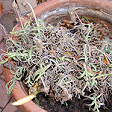
Verticillium albo-atrum is a soil born fungus that normally infects the roots acting on the water conducting cells by restricting flow causing the plant to wilt. On trees the leaves suddenly wilt and die. This may happen on individual branches on one side of the tree. Other symptoms are leaves form smaller than usual turning yellow and the plant may not shoot the following season. Trees may die over a short or long period of time depending on the severity or number of infections it has incurred and Acer saccharinum and Catalpa species are most susceptible.
Source and Dispersal
It is found in the soil and dispersed by movement of soil i.e. in containers or on machinery. The fungus may survive in the soil for many years.
Favoured Conditions
Moist poorly drained soils are prone to fungus and during the cooler humid months the fungus is most active.
Affected Plants
There is a wide range of hosts including tomatoes, potatoes, chrysanthemums and other perennials. It also found in shrubs and trees.
Acer, Achillea, Koelreuteria , Paeonia and Syringa species are infected by Verticillium albo-atrum causing wilting. Erythrina x sykesii may also become infected.
Berberis species are infected with Verticillium albo-atrum causing the leaves to turn brown, shrivel then die.
Non-chemical Control
Cultivate soil to improve drainage and aeration. Cut down and destroy any infected plant material and when taking cuttings from a susceptible plants quarantine them, to ensure they are not infected. Infected soil may be allowed to lay fallow for 2 to 3 years and when replanting used resistant plant varieties.
Chemical Control
For quick control of a cultivated area the soil will require treatment with a fungicide. Consultation with your local Department of Agriculture is advised.
Note
Always read the label for registration details and direction of use prior to application of any chemicals.
DISEASE
NAME
Rust (General)
Various Rust Species
Description
Generally this fungal problem involves many species causing a range of symptoms, but generally produces pustules that release reddish - brown spores. Most fungus is specific to its host and normally will not infect other plant species.
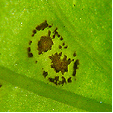 Pustules
Pustules
Symptoms
The upper leaf surface develops red, brown or yellow areas and the underside produces bright yellow to orange spores that correspond to the patches above. Infested leaves become brown in patches, fall prematurely and flower and fruit may also be infected. This overall, results in a loss of vigour and in small plants may lead to death.
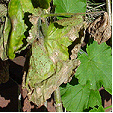 Pelargonium x hortorum
Pelargonium x hortorum
Myrtle Rust (Puccinia psidii) This fungal disease infects plants in the Myrtaceae family and was only recently detected in 2010 and has since spread across eastern Australia from the Northern Territory to Queensland, NSW, Victoria and Tasmania. This rust attacks soft and actively growing foliage or shoots with varying symptoms. It normally starts as small purple spots on the leaves from which spores form in yellow pustules that fade to grey as the infection matures and can merge creating leaf distortion and death of the plant.
The life cycle starts when the powdery yellow spores are distributed by wind to other plants where they germinate and start to grow by piercing the plant cells to obtain nutrients. Germination occurs in dark moist positions with a temperature between 15° to 25°C and the new pustules can release spores in 10 to 12 days, (spores remain viable for 3-months). The spores spread rapidly by wind, water, insects or animals. They are also distributed by plant material, clothing, shoes and vehicles.
 Puccinia psidii
Puccinia psidii
Needle Rust (Melampsora farlowii) infects the new leaves turning them to yellow and fall from the shoot giving the branch a scorched appearance. The fruiting bodies are found on the underside of the leaf and is waxy-red.
Rust in Poplar (Melampsora species). A fungal problem involving at least two species (Melampsora medusae) and (Melampsora larici-idaei).
The upper leaf surface becomes flecked with yellow to light green and the underside produces bright yellow orange spores that correspond to the patches above. Infested leaves become brown in patches, fall prematurely and shoots may die back as a result of not being hardened off to the elements. This overall, results in a loss of vigour and in small plants may lead to death.
The source of the fungus is from other infected plants or fallen leaves and is dispersed by wind.
Host plants include Lombardy Poplars particularly Populus nigra 'Italica' and cottonwoods.
White Rust (Albugo candida) forms snow white pustules that contain colourless spores that turn yellow then brown and are found on the underside of leaves.
White Pine Blister Rust (WPBR) is caused by the fungus (Cronartium ribicola). It is a obligate parasite requiring a living host to survive. The life cycle requires two host species with part of it life on the Pinus species and the other part on Ribes species. First cankers or sores appear on the Pinus species realising spores that land on the Ribes species infecting it. The infection produces a different type of spore that land on the needles and growing branches of the Pinus species and eventually forming cankers. The spores are spread by wind and prefer cool moist conditions. Symptoms include brown spots on the needles and the appearance of dead branches in the crown. Cankers will also appear on the trunk and it tends to attack young trees. Control methods include removal of Ribus species in the affected areas and breading naturally resistant Pinus species.
The Rust (Endophyllum sempervivi) affects Sempervivum species by infecting the young leaves and eventually the crown. The mycelium then travels to the roots and extends into any off shots. Leaves that are infected turn yellowish, grow longer and are thin. Persistent infection may kill the plant.
Source and Dispersal
The source of the fungus is from other infected plants or fallen leaves that contain the fruiting bodies and is dispersed by wind.
Favoured Conditions
Generally rust is more prevalent during summer, preferring warm humid conditions and particularly when the leaves are damp.
Affected Plants
A wide range of ornamental annuals, perennials, ferns, trees, shrubs including, Hibiscus species that are infected by Kuehneola malvicola predominantly in southern USA.
Abies species are infected by many types of rust including (Milesia fructuosa) and (Uredinopsis mirabilis).
Abutilon, Phymosia and Alcea species are infected by the rust (Puccinia heterospora).
Alnus species are occasionally infected with Leaf Rust (Melampsoridium hiratsukanum) which forms yellowish pustules on the leaves that develop turning the leaf brown.
Amelanchler species and Calocedrus decurrens are infected by several rust species including (Gymnosporangium libocedri).
Antirrhinum majus (Snapdragon) is infected by the rust (Puccinia antirrhini). This fungal problem that infects the epidermal layer on the leaf underside, forming pale green areas that are raised and split open revealing reddish brown spores that have a dusty appearance.
As the infestation grows, concentric rings of spore pustules appear around the original infection. The corresponding position on the upper leafs surface turns yellow eventually causing the leaf to wilt and die. The infestation is not restricted to the leaves; all above ground parts of the plant are susceptible and infected plants transmit the fungus dispersing it by wind.
Infected plants should be removed and destroyed.
Anemone and Prunus species are infected by the rust (Tranzschelia pruni-spinosae) that stimulates abnormal growth in the plant during spring.
Aquilegia, Anemone, Delphinium and Clematis species are infected by the Rust (Puccinia rubigo-vera var. agropyri).
Arctostaphylos manzanita is infected by the rust (Pucciniastrum sparsum) occurring in coastal regions but is not normally detrimental to the plant.
Artemisia species are infected by the rust (Uromyces ari-triphylli) which is a systemic disease that is transmitted through seeds. It causes the leaves to turn yellow then die and can infect all parts of the plant except the roots.
Bambusa species are infected by the rust (Dasturella divina) which forms elongated brownish strips on the leaves.
Berberis species may be infected by the Rust (Puccinia graminis) that forms orange spotting on the leaves. It certain regions plants infected with this rust must be removed and destroyed to avoid infecting neighbouring agriculture crops.
Betula species may be infected by Leaf Rust (Melampsoridium betulinum) that forms reddish-yellow spots on the leaves and heavy infestation can defoliate the tree. The host tree changes to Pseudolarix species during the sexual stage and causes blistering of the leaves.
Calendula species may be infected by the Rust (Puccinia flaveriae).
Callistephus and Solidago species may be infected by the Rust (Coleosporium solidaginis) which forms bright yellow spots particularly on new foliage or young plants.
Canna species may be infected by the rust (Puccinia Thaliae).
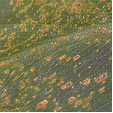
 Canna indica
Canna indica
Centaurea species are infected by the rust (Puccinia cyani) and (Puccinia irrequisita) which can cover the stems and leaves.
Cleome species are infected by the rust (Puccinia aristidae) but rarely requires control.
Dianthus species are infected by the rust (Uromyces dianthi) which forms powdery brown spots that appear on both sides of the leaves. The leaves curl and die and the plant becomes stunted. This is a common problem that occurs when grown in a protected enclosure (hot house).
Ficus species are infected by the rust (Cerotelium fici) which forms small brown spots, and causes the leaves to turn yellow then fall prematurely.
Fuchsia species are infected with (Pucciniastrum epilobii). This fungus caused purplish red blotches on the upper leaf surface, that become dry in the middle and result in a brown patch with purple edges. On the underside of the leaf, corresponding to the patches, yellow orange spores form. Heavily infected leaves become yellow and drop prematurely. This leads to a loss of vigour in the plant and infected plants transmit the fungus.
Certain cultivars are more susceptible than others, particularly 'Orange Drops' and 'Novella'.
Hydrangea species is infected by (Pucciniastrum hydrangeae) causing yellowish brown pustules to appear on both sides of the leaf. The leaf becomes dry and brittle.
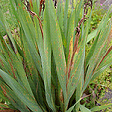
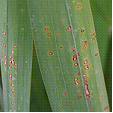 Iris species
Iris species
Iris and Dietes species are very susceptible to the rust (Puccinia iridis). Leaves form rusty red powdery spots that enlarge. They are appear on both sides of the leaves causing the surrounding area to turn pale yellow then brown and the black spores appear soon after, overwintering on dead infected leaves. Plants may be heavily infected but normally survive attack.
Larix species are infected by several Needle Rusts including (Melampsora paradoxa), (Melampsora medusae) and (Melampsoridium betulinum). The fungi attacks the needles predominantly towards the branch tips turning them yellow and eventually killing them . The underside of the leaf develops pale yellow fruiting bodies.
Lupinus species are infected by three species of rust including (Puccinia andropogonis var onobrychidis).
Malus andChaenomeles species may be infected by the rust (Gymnosporangium juniperi-virginianae) or (Gymnosporangium clavipes) which forms brown or bright orange spots on the leaves or twigs and can defoliate the tree. Juniperus virginiana and Mespilus germanica may also be infected by rust.
Mathiola and Arabis species are infected by White Rust.
Pinus species are infects by the Comandra Blister-rust (Cronartium comandre).
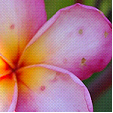
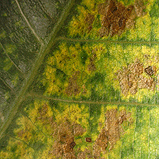
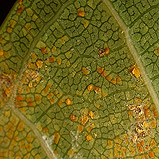
Plumeria rubra Leaf upper surface Leaf underside
Plumeria species are susceptible to the rust (Coleosporium plumeriae). Leaves and flowers may be infected with the underside forming bright yellow pustules and causes premature leaf or flower drop.
Populus nigra 'Italica' is infected by the rust (Melampsora species) which forms pustules to form on the leaves turning them brown and causing premature leaf drop.
Rhododendron and Tsuga species are infected by the rust (Pucciniastrum vaccinii) and is commonly found in nursery stock, spreading rapidly. Tsuga species are also infected by Needle Rust.
Ribes species are infected by the rust (Cronartium ribicola). This leaf rust appears on the underside of the leaves (preferably older leaves) forming dusty brown pustules and is a serious problem. This rust only appears when White Pine (Pinus strobes) grows near where the alternate stage of the fungus occurs.
Rudbeckia species are infected by several species of rust including (Puccinia dioicae) and (Uromyces rudbeckiae).
Salix species are infected by four types of (Melampsora species).
Senecio, Bellis and Calendula species are infected by the rust (Puccinia lagenophora) which forms blister-like pustules that release brown spores.
Sorbus aucuparia is affected by several rust from the (Gymnosporangium species) causing circular yellow spots, that appear on the leaves during summer and develop into orange cup-shaped fruiting bodies.
Trillium species are infected by the rust (Uromyces halstedii) that damages the leaf surface.
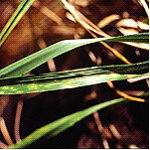 Festuca arundinacea
Festuca arundinacea 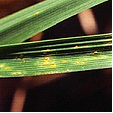 Rust
Rust
Turf Grass are susceptible to rust (Puccinia species) and (Uromyces species), causing yellow flecks to appear on the stems and leaves. These markings enlarge before the pustules form and in severs cases the lawn has a yellow, red or brown appearance.
The infection appears from spring to summer under humid low light conditions and turf that is under stress or with excessive nitrogen in the soil is more susceptible. Many species may be infected including Lolium perenne (Perennial Ryegrass) and Poa pratensis (Kentucky Bluegrass).

 Rust on Perennial Ryegrass
Rust on Perennial Ryegrass
Viburnum species are mildly affected by two types of rust (Coleosporium viburni) and (Puccinia linkii).
Viola species are infected by the rust (Puccinia violae) which forms green spots on the underside of the leaves. It is not commonly seen on cultivated plants.
Non-chemical Control
Cut off and destroy any infected branches, fallen leaves and remove heavily infected plants. Improve the culture by, pruning to improve air circulation, allow space between plants and avoid over crowding. Avoid planting susceptible species. Plants that are infected with a systemic form should be removed and destroyed
Chemical Control
Not possible to spray large trees but young plants may be treated with a protectant fungicide such as wettable sulphur. In a domestic garden small plants such as Fuchsia species may be sprayed with a protectant chemicals as symptoms appear, aided by the removal of existing infected leaves. Under commercial conditions stock may be sprayed with a fungicide such as oxycarboxin.
Note
Always read the label for registration details and direction of use prior to application of any chemicals.
DISEASE
NAME
Root Knot & Other Nematodes
Meloidogyne & other species
Description
Root Knot Nematode or eelworms are transparent thin nematodes that are an organism up to 0.5mm long and attacks the roots by injecting saliva that stimulates the surrounding cells to form galls. The adult male lives in the soil and the female are found in the roots, laying up to 2,000 eggs in a mass in the soil adjoining the roots.
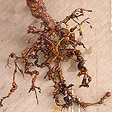
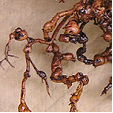
Symptoms
Above ground the plant infected by Root Knot Nematode develops slowly and is stunted. During hot weather the plant wilts easily as it is unable to keep up with the transpiration rate and under extreme conditions the plant dies. The young nematodes attack the roots forcing there way up the root tips forming galls. On inspection the galls are found centrally located along the roots and are up to 20mm across. The galls slow the rate of nutrients and water passing through the plant and as the galls break down they allow opportunity for other diseases to enter the plant.
The roots are severely damaged if the galls are physically removed.
Other species of nematode have simular symptoms and are individually discussed below.
Source and Dispersal
The nematodes are found in soil or in infested plants and are dispersed by water, soil movement and attached to tools or shoes.
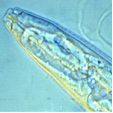 Nema Head
Nema Head
Favoured Conditions
It prefers sandy soil types and a warm moist weather conditions.
Life Cycle
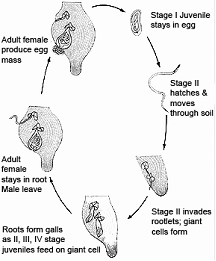
Affected Plants
A wide range of plants are attacked by the Root Knot Nematode including tomatoes, potatoes, carrots, tobacco, hibiscus, gardenia and roses. Some species of nematodes are plant specific such as (Meliodogyne incognita) which attacks Hemerocallis, Celosia and Viola species, forming small wart-like swelling on the roots.
Alternanthera, Begonia, Dianthus, Psidium, Thunbergia and Weigela species are attacked by the Root Nematode (Meloidogyne incognita). This forms small swellings on the roots causing the top growth to be stunted and not responding to improved culture. In cool climates it is found on plants in glasshouses.
Buxus species are attacked by the Meadow Nematode (Pratylenchus species) that turn the leaves a bronze colour and cause stunting of the plant. These microscopic nematodes enters through the roots and eventually result in the death of the plant.
Lagunaria patersonii is attacked by a simular nematode, the Root Burrowing Nematode (Radopholus similis) that feeds by burrowing in the outer root tissue.
Lavandula species that are grown in the northern United States are susceptible to the Peanut Root Knot Nematode (Melioidogyne hapla). Berberis species are also susceptible.
Tulipa species are attacked by Bulb and Stem Nematode (Ditylenchus dipsaci) which forms brownish streaks along the stem that may blister and may cause wilting. The flowers petals become distorted and the general vigour of the plant poor.
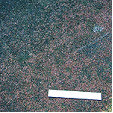
 Nematodes damage
Nematodes damage
Turf Grass are susceptible to several Parasitic Nematodes including (Helicotylenchus species), (Xiphenema Species), (Hemicycliophora species) and (Ibipora lolii). All turf grasses are susceptible and the nematodes are active from spring to autumn requiring a soil temperature 15 ºc. The leaves become chlorotic and have a weak appearance as a result of the damaged roots. Generally it is only a major problem when the nematode numbers are very high, otherwise control is not warranted.
Cultural Control
Crop rotation in infected soils, avoid using plants from the Brassicaceae family for up to four years and plant species that are tolerant of nematodes, this will reduce numbers. Beds may be laid fallow for several seasons to deter nematodes, but numbers build up quickly once susceptible plants return.
Affected plants such as roses may have the bare roots dipped in hot water 45ºC for 15 minutes during the dormant period and contaminated growing media can be heat treated at 60ºC for 30 minutes before being used.
Any infested plants should be removed and destroyed or deposed off site.
Improve the soil structure and avoid acidity by the addition of lime or dolomite. Garden beds may also be pre planted with marigolds or mustard to deter nematodes, but should be removed or thoroughly composted prior to planting as they can push nematodes towards the crop. Green manure crops may be grown prior to planting and infested soil may require up to three seasons of manure crops to bring nematodes under control.
Biological Control
The encouragement of earthworms reduces nematode numbers as they accidentally eat them in there normal course of growth.
Chemical Control
The soil can be treated with a nematicide such as fenamiphos in a domestic situation. Commercial growers may fumigate the soil prior to planting with the appropriate chemicals.
Note
Always read the label for registration details and direction of use prior to application of any chemicals.
DISEASE
NAME
Leaf Spot (General)
Various Leaf Spot Species
Description
There is a wide variety of fungal leaf spots that infect perennials, shrub and trees. Some are specific to the host while others can affect a range of plants.
Symptoms
Generally light brown to purplish or blackish spots appear on the leaf and form concentric rings of fruiting bodies. The spots may leave holes, perforating the leaf or expand with pale green to yellowish margins and when the holes merge the leaf normally dies. There are many different types of leaf spot, some are discussed below.
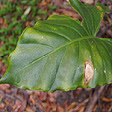 Alocasia species
Alocasia species 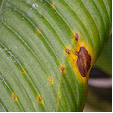
Alternaria Leaf Spot (Alternaria nelumbii) forms a small reddish brown spots that are boarded in light green, and as they develop in size the leaf curls and dies from the margin inwards. Normally occurs on Nelumbo species (water lilies).
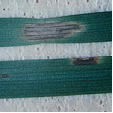 Helminthosporium Disease
Helminthosporium Disease
Helminthosporium Disease (Bipolris species), (Drechslera species) and (Exserophilum species) are responsible for several leaf spots that occur on all Turf Grass species. Generally they form black or white spots that may be faded and produce masses of spores in the thatch during late summer, under humid conditions. The life cycle is short and when conditions are favourable spores are splashed onto the foliage from the thatch, causing wide spread infection. Cynodon dactylon (common couch) is most susceptible and found in bowling or golf greens where it is a serious problem.
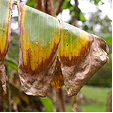 Banana Leaf Spot
Banana Leaf Spot 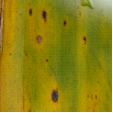
Banana Leaf Spot (Mycosphaerella musicola) is found on many species of banana causing pale yellow streaks on the young leaves to turn brown with dark spots. The leaf then becomes dried, brown and dead commencing from the margins, eventually the leaf dies. Control requires removal of infected foliage or the spraying of a fungicide and fungicides should not be used during the fruiting period.
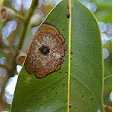
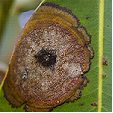 Lophostemon confertus (Brush Box)
Lophostemon confertus (Brush Box)
Leaf Spot on Brush Box (Elsinoe species). This is a casual fungus that attacks the epidermal layer of the leaf, forming circular spots that are up to 25mm across and are often restricted by the main vein. These spots are a dull yellowish brown but can also have purplish patterns. A leaf may have more than one spot develop on its surface and normally appears on scattered leaves throughout the tree. This doesn't affect the vigour of Lophostemon confertus.
Palm Leaf-scab (Graphiola phoeicis) appears as yellow spots and develop into scabs or warts that are outwards hard and dark but with a soft centre with powdery yellowish brown spores. The infected leaves eventually die.
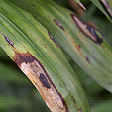 Palm Leaf Spot, Chamaedorea elegans
Palm Leaf Spot, Chamaedorea elegans
Palm Leaf Spot (Pestaloptiopsis species) appears as a small spot with a dark centre on the leaves and affects palms that are growing in shaded humid positions and normally control is not required, though infected fronds should be removed.
Source and Dispersal
Infection source is other contaminated plants and the spores are spread by wind or by splashing water. The fruiting bodies are black spots that appear on the damaged tissue releasing spores.
Favoured Conditions
This fungus prefers a warm humid environment and leafy plants with soft new growth, particularly if they are crowded.
Affected Plants
There are many ornamental and native plants that are hosts to a wide range of fungal leaf spots. Some specific ones are listed below. Plants such as Cornus or Paeonia species are infected by a large variety of leaf spots, while other plants attract a specific leaf spot.
Generally a healthy plant can tolerate fungal leaf spot attack, though it may make the plant look unsightly. In trees and shrubs it is difficult to control and generally not necessary, but in perennials and annuals control may be necessary in order to save the plant.
Acalypha and Arctotis species are infected by up to three leaf spots including (Cercospora acalyphae) and (Ramularia acalyphae) that rarely require control.
Acer species are infected by Purple Eye (Phyllosticta minima) which forms spots with brownish centres and purplish margins causing the death of the leaves.
Acer species are also infected by Tar Spot (Rhytisma acerinum) which forms round black spots that have yellow margins. Not normally seen on cultivated trees, but seen in forests.
Adiantum, Asplenium, Blechnum, Cyathea, Davallia, Nephrolepis, Platycerium, Polypodium and Pteris species are infected by the leaf spot (Pseudocercopora species) which forms circular brown spots on the fronds and heavy infection can defoliate a plant.
Aesculus species are occasionally infected with the leaf spot (Septoria hippocastani) which forms small brown spots.
Agave species are susceptible to the leaf spot (Coniothyrium concentricum), which appear as greyish spots up to 20mm (1in) across with concentric rings and black fruiting bodies. Affected leaves are destroyed as the infection spreads.
Albizia julibrissin is susceptible to the fungal leaf spot (gloeosporium aletridis), which does not normally require control.
Amelanchler, Chaenomeles, Crataegus and Rhaphiolepis species Mespilus germanica are infected by the leaf spot (Fabraea maculata) which may cause considerable damage during wet periods.
Aquilegia species can be infected by three types of Leaf Spot including (Ascochyta aquilegiae), (Cercospora aquilegiae) and (Septoria aquilegiae), normally appearing during humid conditions forming spots on the leaves.
Arbutus species are infected by two leaf spots (Septoria Unedonis) which produces small brown spots on the leaves and (Elsinoe mattirolianum).
Arctostaphylos manzanita is infected by the leave spot (Cryptostictis arbuti) which damages leaves but is not normally detrimental to the shrub.
Aspidistra species are infected by the leaf spot (Colletotrichum omnivorum) causing whitish spots on the leaves and petiole.
Aster species are infected by many leaf spots including (Alternaria species), (Cercosporella cana), ( Ovularia asteris) and (Septoria asteris).
Aucuba species are infected by several leaf spots, usually as a secondary infection after aphid attack. These include (Phyllosticta aucubae) and (Phyllostica aucubae).
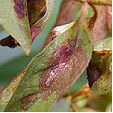
 Azalea
Azalea
Azalea (Rhododendron species) are susceptible to Leaf Scorch (Septoria azalea). This fungal disease forms reddish- brown spots which expand and engulf the leaf, with fruiting bodies appearing in the centre. Infected leaves die, then fall and the branchlets wilt. This problem is more serious during wet periods and may require control using a fungicide.
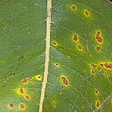 Banksia robur
Banksia robur
Banksia species are infected by several leaf spots causing chlorotic areas that have brown centres and is not normally a major problem for the plant.
Betula species may be infected by the Leaf Spots (Gloeosporium betularum) that forms brown spots with darker margins and (Cylindrosporium betulae) that also forms brown spots with faded indefinite margins.
Bougainvillea species are infected by the leaf spot (Cercosporidium bougainvilleae) which forms rounded spots with dark margins that yellowish ting. Infected leaves die and fall from the plant.
Calendula species are infected by the Leaf Spot (Cercospora calendulae) which rapidly infects the plant spotting the leaves and killing the plant.
Callicarpa species may be infected by the leaf spot (Atractilina callicarpae) forming irregular brownish spot or (Cercospora callicarpae) which can defoliate the plant in subtropical climates.
Campsis species may be infected by several fungal leaf spots including (Phyllosticta tecomae), (Septoria tecomae) and (Cercospora duplicata).
Carpinus species are infected by the leaf spots (Gloeosporium robergei), (Gnomoniella fimbriata) and (Septoria carpinea), all are minor infections not normally requiring control.
Carya species are infected by several leaf spots including (Gnomonia caryae) that infects leaves with irregular reddish spots on the upper surface with corresponding brown spore producing spots on the underside. It also has a secondary spore release that occurs on the dead leaves where it over winters. Other leaf spots include (monochaetia desmazierii) and (Marssonina juglandis).
Ceanothus species are susceptible to the leaf spot (Cercospora ceanothi) and (Phyllosticta ceanothi) both are of minor importance not requiring control.
Celtis species are infected by many leaf spots including (Cercosporella celtidis), (Cylindrosporium celtidis), (Phleospora celtidis) and (Septogloeum celtidis).
Chrysanthemums species are infected by the leaf spot (Septoria species) which forms yellow spots appear toward the edge of the leaves; these become enlarged brownish patches with yellow margins. Damaged areas may converge and in severe attacks and the leaves may fall prematurely or flower production is reduced.
Clematis species are infected by the fungal disease (Ascochyta clematidina) which may cause stem rot or leaf spots that are water soaked areas with reddish margins. The infection spreads from the leaves to the stem causing wilting and eventually girdling the stem killing the plant. There are many fungal leaf spots that infect this plant including (Cercospora rubigo) and (Septoria clematidis)
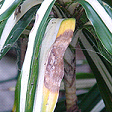 Dracaena deremensis
Dracaena deremensis
Cordyline and Dracaena species may be infected by the leaf spot (Phyllosticta maculicola) which forms small brownish spots that have yellowish margins and has black fruiting bodies that forms coils of spores. These plants are also susceptible to other leaf spots such as (Glomerella cincta) and (Phyllosticta dracaaaenae). Keep foliage dry to avoid infection.
Cynodon dactylon, Pennisetum clandestinum and many other Turf Grasses are susceptible to Helminthosporium Disease.
Daphne species are infected by the leaf spot (Gloeosporium mezerei) and (Marssonina daphnes) both of which form thickish brown spots that are seen on both sides of the leaves. Infected leaves turn yellowish before dieing.
Dendranthema species are infected by many leaf spots such as (Septoria chrysanthemi) which first forms yellowish spots up to 25mm (1in) across that become black. Infected leaves die prematurely and persist on the plant.
Dianthus species may be infected by the leaf spot (Septoria dianthi). It forms light brown rounded spots that have a purplish border. The scattered spots on the lower leaves can also be found on the stems and the spores are dispersed by water from the tiny black fruiting bodies.
Dieffenbachia species are infected by several leaf spot fungi including (Cephalosporium species) and (Myrothecium species).
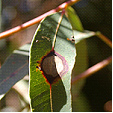 Eucalyptus species
Eucalyptus species
Eucalyptus species are infected by many fungal leaf spots such as (Mycosphaeralla species), (Hendersonia species) and (Monocheatia monochaeta). Generally leaf spots appear on the juvenile or new leaves causing brownish spots that enlarge and may have a purplish halo around the margin. Mature adult leaves are not normally infected and the trees rarely require control measures.
Fern species are infected by the leaf spot, (Alternaria polypodii). This fungus appears as brown circular or oblong spots that congregate along the margins of the pinnae causing the fronds to turn brown and die. It is spread by wind currents from plant to plant and control methods include removing infected fronds and maintaining a drier atmosphere.
Ficus species are infected by various fungal leaf spot including (Pseudocercospora species). Generally the fungal attack forms circular or irregular dark coloured spots on the leaves eventually causing them to fall prematurely.
Ficus elastica is susceptible to many fungal leaf spots including (Alternaria species), (Leptostromella elastica) and (Phyllosticta roberti).
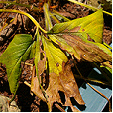
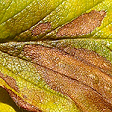 Strawberry
Strawberry
Fragaria x ananassa (Strawberry) is infected by the fungal leaf spot (Mycospharella fragariae). The mature leaf is initially infected with well defined brown spots that that turn light grey with red-purplish margins. As the spots merge they form large brown blotches and the leaf turns yellow then dies. This fungal attack normally occurs on plants in poor health and can be a serious problem early in the season seriously damaging stock.
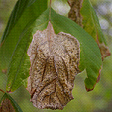 Fraxinus species
Fraxinus species
Fraxinus species are infected by the leaf spot (Gloeosporium aridum) giving the leaf a scorched appearance as large blotches appear from the margin or apex and turn brown with a papery texture. It is more prevalent during rainy periods and infected leaves fall prematurely. Collect and depose of fallen leaves otherwise control is not normally required.
Fuchsia species may be infected by the leaf spot (Septoria species) or ( Cercospora species), both form spots with dead centres and dark margins.
Gladiolus species are infected by Hard Rot or Leaf Spot (Septoria gladioli). On the corms reddish brown circular water soaked spots become large and sunken. These areas dry out and form obvious margins. The leaves may also have these symptoms but is not commonly seen.
Hemerocallis species are infected by several leaf spots including (Cercospora hemerocallis) and (Heterosporium iridis). These may be in the form of black spots or brownish spots that converge killing the leaf. Infected leaves should be removed and burnt.
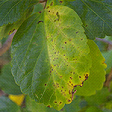 Hibiscus species
Hibiscus species
Hibiscus rosa-sinensis, Hibiscus syriacus and Hibiscus tiliaceus are susceptible to several fungal leaf spots including (Ascochyta abelmoschi), (Cerospora kellermanii) and (Phyllosticta hibiscina). All cause spotting or blotching of the leaf surface; remove and destroy infected parts.
Hydrangea species are infected by four fungal species including (Ascochyta hydrangeae), (Phyllosticta hydrangeae) and (Septoria hydrangeae).
Iris species are infected by several fungal leaf spots including (Alternaria iridicola) and (Macosphaerella species).
Iris species are also infected by the leaf spot (Didymellina macrospore) that forms greyish spots with brown water soaked borders and coalesce on the upper part of the leaf. This casual organism commonly occurs after flowering killing the leaves but will not infect the bulbs. The bulbs become weak over several seasons due to the decreased foliage.
There is also a Bacterial Leaf Spot (Bacterium tardicrescens) that is commonly mistaken as a fungal problem causing translucent spots that coalesce and involve the entire leaf. Normally found on Iris species.
Laburnum anagyroides is infected by the Leaf Spot (Phyllosticta cytisii). The leaf forms light grey spots with no definite margin and mature to brown. The black fruiting bodies appear as dots in the centre of the spot.
Leucanthemum species are infected by the leaf spot (Cerocspora chrysanthemi) and (Septoria leucanthemi).
Magnolia species are susceptible to many species including (Alternaria tenuis), (Mycosphaerella milleri) and (Phyllosticta species). Leaves generally turn brown from the apex or margins turning brown or spots appear on the leaf surface and leaves become yellow before withering and dieing. Normally the make the tree look poorly but have little effect on its growth. Control is not normally required.
Nerium oleander is susceptible to several fungal leaf spots including (Cercospora nerella), (Cercospora repens), (Gloesporium species) and (Phyllosticta nerii). Infected leaves should be removed but generally control is not required.
Nyssa sylvatica is infected by the leaf spot (Mycosphaerella nyssaecola) forming irregular purplish blotches.
Orchids such as Cattleya, Cymbidium, Cypripedium, Dendrobium, Epidendrum, Paphiopedilum, Phalaenopsis and Zygopetalum species are infected by several leaf spots including (Cerospora, Colletotrichum and Phyllosticta species). Normally forming dark or dead, circular or irregular areas on the leaves.
Palms such as Syagrus, Howea, Phoenix, Roystonea and Washingtonia species are infected by Leaf-scab (Graphiola phoeicis).
Palms such as Archontophoenix, Caryota, Chamaedorea, Cocos, Dypsis, Howea, Liculia, Linospadix, Livistona, Phoenix, Ptychosperma, Rhapis, Roystonea, Syagrus, Washingtonia and Wodyetia species are susceptible to several fungal leaf spots including;
(Bipolaris spp.), (Cylindrocladium spp.), (Colletotrichum spp.) and (Pestalotiopsis spp.).
Generally the circular leaf spots are brown and may have a yellow halo such as Palm Ring Spot (Bipolaris incurvata). They vary in size from small to large depending on the species. When a plant is healthy it recovers from attack, but heavy infections can defoliate, causing the collapse of the plant.
Palms are also infected by the Brachybasidium Leaf Spot (Brachybasidium pinangae). This fungus forms angular leaf lesions that produce fruiting bodies on the underside and is commonly found on Archontophoenix species.
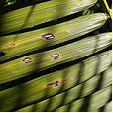
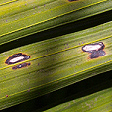 Archontophoenix cunninghamiana
Archontophoenix cunninghamiana
Passiflora species are infected with many types of leaf spot such as (Alternaria passiflorae).
Phoenix species are susceptible to False Smut (Graphiola phoenicis). This fungus forms yellow leaf spots that become hard with a raised with a blackish scab, which produces masses of powdery spores that are thread-like.
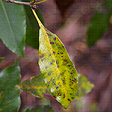
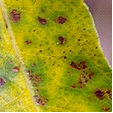 Pittosporum species
Pittosporum species
Pittosporum species are susceptible to the leaf spots (Alternaria tenuissima), (Phyllostica species) and (Cercospora pittospori). Circular or angular dark spots appear on the leaves and are surrounded by necrotic areas that are yellowish. Generally removal of infected leaves is adequate control.
Poa species and other cool season grasses are infected by Winter Fusarium Leaf Disease (Fusarium species), which causes small pale spots that are water soaked to appear on the leaves that turn red-brown. Infected leaves become bleached then wither and die, but the infection will not affect the crown or roots of the plant. It can be identified by pink, cotton-like mycelium and the plant prefers cold wet weather.
Populus species are infected by several fungal leaf spots including (Ciborinia bifrons, Ciborinia confundens), and (Mycosphaerella populicola).
Prunus species are infected by several leaf spots including (Cercospora circumscissa and Septoria ravenelii).
Pseudotsuga menziesii Douglas Fir is infected by the Leaf Cast (Rhabdocline pseudotsugae) Symptoms include the needles becoming yellowish at the apex and extending down the needle and spreading to others during moist spring weather turning them brown. Brownish scorched areas are noticeable on the tree from a distance. Control; is not normally required for mature trees but nursery stock may require spraying with a copper based fungicide.
Psidium guajava (Guava) is infected by (Glomerella cingulate). This fungus courses spots to appear on leaves and mummifies and blackens immature fruit or rots mature fruit. This fungus can devastate a guava crop.
Quercus species are infected by several types of leaf spot including (Cylindrosporium microspilum) and (Marssonina martini). These attacks tend top take place later in the season and normally not detrimental to the tree.
Rhododendron species are infected by a large variety of fungal leaf spots including (Cercospora rhododendri) and (lophodermium melaleucum)
Salix species are infected by several fungal leaf spots including (Ascochyta salicis) and (Septogloeum salicinum).
Senecio species are infected by the fungal leaf spot (Alternaria cinerariae) and (Cercospora species), forming dark rounded or angular spots.
Spiraea species are attacked by the fungal leaf spot (Cylindrosporium filipendulae).
Stenotaphrum secundatum (Buffalo) turf grass is susceptible to Grey Leaf Spot (Pyricularia grisea) in domestic and commercial situations devastating lawns. This fungal disease infects the stems and leaves with small brown lesions that enlarge rapidly forming grey-brown spots that have darker borders or surrounded by yellow chlorotic areas. This infection is commonly found on newly laid turf but will also infect established lawns. It is most prevalent during warm humid periods in soil with a high nitrogen level.
Syringa species are attacked by up to six species of leaf spot including (Cercospora lilacis) and (Phyllostica species).
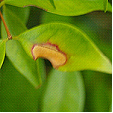 Syzygium species
Syzygium species
Syzygium species are infected by fungal leaf spots but normally control is not required.
Tagetes species are infected by the leaf spot (Septoria tageticola), which starts at the base and moves progressively up through the plant, covering the leaves in grey to black spots.
Trillium species are host to several leaf spots, including (Colletotrichum peckii) (Gloeosporium Trillii) (Heterosporium trillii).
Ulmus species are infected by many fungal leaf spots including (Gnomonia ulmea) and (Cercospora sphaeriaeformis).
Veronica species are infected by the leaf spot (Septoria veronicae). The symptoms include small violet to brown spots appear on the upper surface of the leaf and correspondingly yellowish brown on the underside. The spots converge forming a scorched shot-hole appearance and eventually death of the leaf.
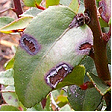 Vaccinium ovatum
Vaccinium ovatum
Vaccinium ovatum is infected by the leaf spot (Rhytisma vaccinii) and (Dothichiza caroliniana).
Vicia species are infected by the leaf spot (Erostrotheca multiformis), which forms greyish spots that enlarge and may defoliate the plant.
Wisteria species are infected by three fungal leaf spots (Phyllostica wisteriae), (Septoria wisteriae) and (Phomatospora wisteriae).
Non-chemical Control
Remove and destroy infected plant material and avoid overhead watering. When planting select infection resistant varieties. Practice crop rotation and add pot ash to the soil to decrease the plants venerability to the disease. Many species of fungus overwinter in fallen leaves, remove and destroy any litter under the plant.
Winter Fusarium Leaf Disease in Turf Grasses can be minimised by aerating the soil, reducing thatch and avoid excessive nitrogen in the soil.
Chemical Control
Protective fungicides such as zineb or copper oxychloride should be sprayed at the first sign of infection and cuttings should be sprayed as they start to grow.
Note
Always read the label for registration details and direction of use prior to application of any chemicals.
Average Lowest Temperature : -5º C 23º F
USDA : 6, 7, 8, 9
This USDA (United States Department of Agriculture) hardiness zone chart can be used to indicate a plant’s ability to withstand average minimum temperatures. However, other factors such as soil type, pH, and moisture, drainage, humidity and exposure to sun and wind will also have a direct effect on your plant’s survival. Use this chart only as a guide, always keep the other factors in mind when deciding where, when and what to plant.
A plant's individual USDA zone can be found in the Plant Overview.
Region of origin
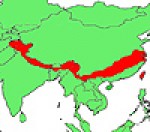
Himalayas, central and western China
Climate Description
Cool Temperate
This zone has low winter temperatures and moderate summer temperatures with low humidity and cool nights. Frosts are severe with snow at higher altitudes.
Drought rarely occurs and wind is cold inland or wet on the coast.
Plant growth
Cool weather plants grow well.
| Dictionary | Growth Habit |
| Leaf Type | Botanic Flower Description |
| Leaf Shape | Flower Inflorescence |
| Leaf Arrangement | Fruit Type |
| Leaf Margin | Bark Type |
| Leaf Apex And Bases | Flower Description |